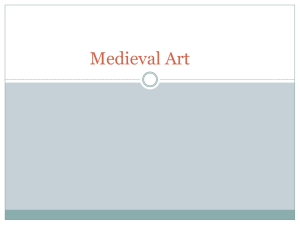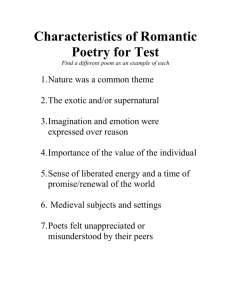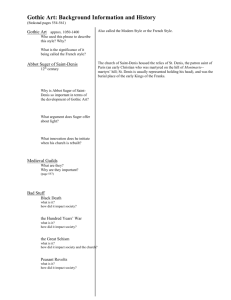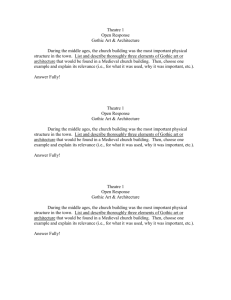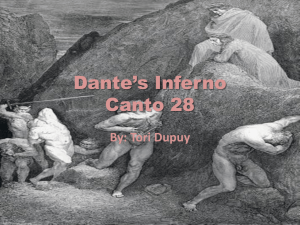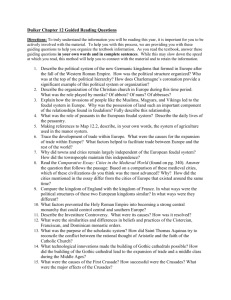The Late Middle Ages: The Gothic Awakening
advertisement
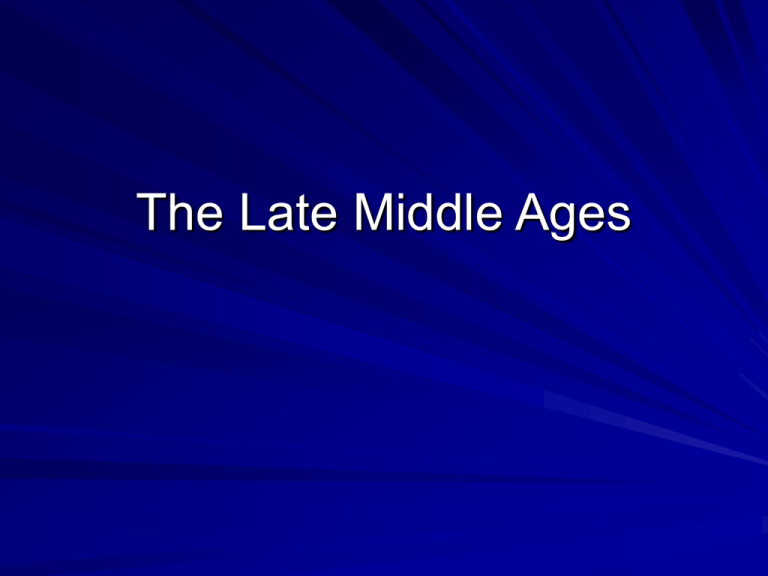
The Late Middle Ages The Crusades 1095: Urban II calls for knights to capture Jerusalem from Muslims Recover Christian lands Lasted three hundred years After 1st Crusade knights killed Arabs and Jews and set up feudal estates Crusaders created demand for Arab goods Arabs fueled intellectual revival in Europe The Decline of Feudalism Crusades fueled conflict between Church and secular leaders Church used excommunication as tool Thomas a Beckett As popes’ power lessened, kings grew in power at the expense of feudal lords The Rise of Towns and Cities Cities became vital Cities were crude and filthy but citizens were free from feudal lords Constitutions guaranteed freedoms Universities were established Middle class emerged: Abbott Suger and the Gothic Style 1085-1151 Rebuilt St. Denis to let light in Light: analogy to God’s spiritual being Technical innovation: glass walls Three elements: Pointed arches,Ribbed vaults and flying buttresses. Created Gothic framework of soaring lines; metaphor for God’s world. Chartres:1194-1240 Other cathedrals rose after St.-Denis Gothic originally termed “French Style” Chartres surpassed all others: perfection of design, stained glass and sculpture. Relic: Mary’s tunic Floor plan: basic Latin Cross but with broader portals on north and south Still has the all of its original glass Chartres’ stained-glass windows 22,000 square feet of colored glass Each depicts a biblical story, life of saint or Christian doctrine Rose window over each portal: both the sun and Mary, “rose without thorns” Lancet windows, shaped like pointed arches Trade and craft guilds paid for and built these windows. Gothic Sculpture Carved symbols, stories and figures of the Bible used to instruct West or “royal”portal shows glory of Christ 1. Incarnation of Christ on right 2. Christ King of Heaven and Earth in center 3. Christ Ascension into Heaven Jamb sculpture: ancestors of Christ, patriarchs, saints. Music and Theater in the Gothic Age Organum: Polyphony or two or more melodic lines playing simultaneously. Sounded like an organ Duplum organum: traditional melody sung by the tenor and held. Duplum voice sang more complex melody above tenor.Two distinct melodic lines independent of other. The Notre Dame School Leading musicians gathered in Paris Leonin compiled sacred music of the time Perotin added third and fourth voices Cantus firmus the complex music of the late middle ages demanded more advanced musical notation and training provided by the Notre Dame School Gothic Theater: From Church to Town Sacred drama outside church: complexity Cooperative between church and town Mystery plays: cycles of plays depicting biblical stories Miracle plays: lives of saints Morality plays: struggle of soul between virtues and vices Vernacular The Universities Organization of scholars to teach and certify lawyers and clerks Baccalaureates in theology, law or medicine No women Paris: theology faculty Strenuous day for students Final examinations oral, during Lent Rediscovery of Aristotle 1150-1250 Aristotle’s works were rediscovered: “The Philosopher” Islamic scholars translated and interpreted Ibn-Sina medical encyclopedia Averroes: best interpretation of Aristotle Maimonides: Jew who wrote of the conflict of reason and faith Thomas Aquinas Synthesized medieval theology and Aristotelian philosophy Summa Theologica wanted to make a science of faith Christian philosophy: “Reason does not destroy faith but perfects it” God reveals himself in works of nature and human reason. Nature leads to God Courtly Love Code of behavior governing relations between the sexes at medieval courts. Court of Eleanor of Aquitaine Paradoxes of medieval society: Marriage not an occasion of fantasy and tenderness. Romance: adulterous longing for forbidden woman Woman powerful over man The Medieval Romance Tradition Troubadors: lyric poet-singers of Provence Arabic love poetry of Muslim culture in Spain Bernart de Ventadorn, Beatriz de Dia Medieval Romance: long narrative in verse of chivalric adventures and courtly lovers Arthurian legends Music in the Late Middle Ages Secular songs in polyphony: Ars Nova Guillaume de Machaut: sacred motet: polyphonic song form in which the higher voices sang different poetic texts. Instrument played lower part while voices sang freer upper parts in Latin and French Secular music, sung in stanzas accompanied by lute; used sharps and flats Dante’s Divine Comedy The Divine Comedy: three-part poem reflecting his vision of afterlife Metaphor for pilgrimage through life Inferno: Vergil, symbol of human reason Purgatorio: sins are not yet forgiven Paradiso:Guide Beatrice, his ideal love Master own nature, submit to commands of human reason and sacred truth Canto XXVIII The Poets then come to the edge of the Ninth Bolgia which contains the Sowers of Discord. They are walking around the edge of the circle. At one point in the circle stands a demon who hacks at them. By the time they reach him again their wounds are healed and they are hacked anew. Canto XXVIII Dante distinguishes three classes of Sowers of Discord. First are the Sowers of Religious Discord, then the Sowers of Political Discord and finaly is the Sower of Discord Among Kinsmen. One of the Sower of Discord Among Kinsmen they meet is Bertrand De Born. He head is severed and he must hold it up in order to talk to the Poets. Canto XXXIV The Poets see Satan in the distance beating his great wings which is the source of the icy wind of Cocytus. Around them are the sinners who were Treacherous to Their Masters, and this round is named Judecca (named for Judas Iscariot). These sinners lie completely in the ice, their bodies twisted and distorted in every possible manner. Satan In the middle of Cocytus stands Satan who is fixed into the ice which flow all the rivers of guilt, and as he tries to escape their icy clutches by batting his wings, he just freezes himself more solidly into the ice. He has three faces, and in each of the mouths is a man whom he rips eternally with his teeth. The Pit of Hell These men are Judas Iscariot, Brutus, and Cassius. Having seen everything the Poets now climb up Satan himself, and passing the center of gravity they emerge from Hell and begin their ascent of Mount Purgatory. Three-line stanza form: terza rima Holy number three in 33 cantos of each main section + introductory canto= 100 Written in the vernacular Italian, not Latin Uses the device of contrapasso, where the right punishment is given for the sin Puts historical as well as contemporary figures in Hell: creativity: Renaissance Paradiso is full of spiritual love. Feeling and intellect guide human toward divine love. Chaucer’s Canterbury Pilgrims Chaucer poet: entertain circle of friends Canterbury Tales Journey of pilgrims to Canterbury; each for different reason Cross section of English society Irony and insight to human psychology Wife of Bath Human comedy: Creativity: Renaissance Reclaiming the Classical Past Petrarch: continuity between classicism and Christianity: humanism Sonnet: a fourteen line poem dedicated to Laura who died during plague. Christine de Pisan: Wrote poetry and made a living of her writings The Book of the City of Ladies: Goddesses and heroic women Giotto’s Pictorial Revolution Italy’s merchants and traders commerce with Byzantine empire Crusaders sacked Constantinople in 1204 and robbed Byzantine art. Italian cities: hubs of manufacture and finance Byzantine influence in gold surfaces: Cimabue’s Madonna Enthroned Giotto Student of Cimabue; revolutionized painting Madonna Enthroned breaks with medieval style New volume and vitality for figures Drapery falls naturally Throne more believable space Some medieval characteristics: gold haloes inconsistent scale Arena Chapel in Padua Ancient art of fresco painting (paint applied to wet plaster Life of the Virgin, Life of Christ, Passion of Christ Eliminated detail to make scene more emotional and real Pieta: faces and gestures reflect individual emotional responses Interest in individuality: Renaissance
